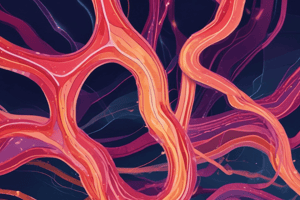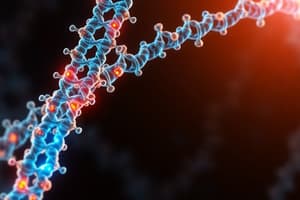Podcast
Questions and Answers
What is the primary function of kinesins in a cell?
What is the primary function of kinesins in a cell?
- To form filaments that support cell structure
- To produce ATP through mitochondrial respiration
- To facilitate the process of transcription
- To generate motion through ATP hydrolysis (correct)
Which type of dynein is primarily responsible for flagella and cilia movement?
Which type of dynein is primarily responsible for flagella and cilia movement?
- Mitotic dynein
- Cytoplasmic dynein
- Molecular dynein
- Axonemal dynein (correct)
How do kinesins compare to myosins in terms of motor domain size?
How do kinesins compare to myosins in terms of motor domain size?
- Motor domains of kinesins are only found in muscle cells
- Kinesins have smaller motor domains than myosins (correct)
- Kinesins have larger motor domains than myosins
- Kinesins and myosins have motor domains of equal size
What cellular components do kinesins help transport?
What cellular components do kinesins help transport?
What type of protein is kinesin classified as?
What type of protein is kinesin classified as?
What is the primary function of Myosin I in living organisms?
What is the primary function of Myosin I in living organisms?
Which Myosin class is specifically involved in organelle transport and found in all brain neurons?
Which Myosin class is specifically involved in organelle transport and found in all brain neurons?
What syndrome is associated with mutations in Myosin V?
What syndrome is associated with mutations in Myosin V?
Which amino acid residues are rich in the tail section of Myosin I?
Which amino acid residues are rich in the tail section of Myosin I?
What structural feature is unique to Myosin VI compared to other myosin classes?
What structural feature is unique to Myosin VI compared to other myosin classes?
What is a characteristic symptom of Elejalde syndrome?
What is a characteristic symptom of Elejalde syndrome?
What region of Myosin I is important for binding to actin?
What region of Myosin I is important for binding to actin?
How many classes of myosin have been identified in the human genome?
How many classes of myosin have been identified in the human genome?
Flashcards
Kinesins
Kinesins
Microtubule-based molecular motors that transport cellular cargo.
Function of Kinesins
Function of Kinesins
They move vesicles, organelles, and chromosome portions within cells.
Dynein
Dynein
Molecular motors that move in the opposite direction to kinesins and are involved in cilia and flagella movement.
Axonemal Dynein
Axonemal Dynein
Signup and view all the flashcards
Cytoplasmic Dynein
Cytoplasmic Dynein
Signup and view all the flashcards
Myosins
Myosins
Signup and view all the flashcards
Myosin Classes
Myosin Classes
Signup and view all the flashcards
Myosin I
Myosin I
Signup and view all the flashcards
GPA Domain
GPA Domain
Signup and view all the flashcards
Myosin V
Myosin V
Signup and view all the flashcards
Elejalde Syndrome
Elejalde Syndrome
Signup and view all the flashcards
Myosin VI
Myosin VI
Signup and view all the flashcards
Calmodulin Binding Region
Calmodulin Binding Region
Signup and view all the flashcards
Signup and view all the flashcards
Study Notes
Myosins and Molecular Motors
- Myosins are biological machines driving movement in living organisms.
Myosin Classes
- Eighteen myosin classes are identified in the human genome.
- Myosin I-XVIII;
- Skeletal, cardiac, and smooth muscle myosins fall under Class II.
Myosin I
- A low molecular weight motor protein associated with cell membranes.
- Contains a tail rich in basic amino acids that can bind to anionic phospholipids.
- Contains a glycine, proline, alanine (GPA) domain facilitating actin binding.
- Involved in membrane-membrane interactions and functions in the brush borders of small intestines.
- Possibly involved in transporting Golgi-derived vesicles.
Myosin V
- Involved in organelle transport (synaptic vesicles, melanosomes, vacuoles, mRNA).
- Found in all brain neurons; required for melanosome transport.
- Mutations linked to neurological disorders and depigmentation, especially hair.
Elejalde Syndrome
- Characterized by silvery hair and CNS dysfunction.
- Large melanin granules unevenly distributed in hair shaft.
- Abnormal melanocytes and melanosomes might be present in fibroblasts.
- Suggests defective mechanisms for melanin movement and distribution.
Myosin VI
- Expressed in most cells and tissues.
- Extended neck region with one calmodulin (IQ motif) binding region per head.
- A dimeric molecule with a coiled tail and two globular ends (one per monomer).
- Defects in the gene cause hearing problems due to hair movement defects in the inner ear.
Kinesins
- Microtubule-based molecular motors.
- Do not form filaments like some myosins.
- Generate motion by conformational changes upon ATP binding and hydrolysis.
- Similar mechanism to myosin actin-based motors.
- Structure includes two heavy chains and two light chains.
- Includes microtubule and ATP binding sites in the head and cargo-binding sites in the tail.
Kinesin 1
- Na/K-ATPase containing vesicle transport via kinesin 1 on microtubules (KLC2, KHC).
Dynein
- Axonemal dynein affecting flagella and cilia movement.
- Cytoplasmic dynein affecting cytoplasmic structure distribution and organization.
- Structure includes a spherical globular head, stalk, and light chains attached to a cargo. Movement on microtubule.
Molecular Motor Comparison
- Comparison diagrams illustrating the modes of action for dynein, myosin, and kinesin heavy chain movement along their respective tracks (microtubules, actin filaments).
Additional Information
- T. Devlin's Textbook of Biochemistry (pp. 979-981) provides further details.
Studying That Suits You
Use AI to generate personalized quizzes and flashcards to suit your learning preferences.




